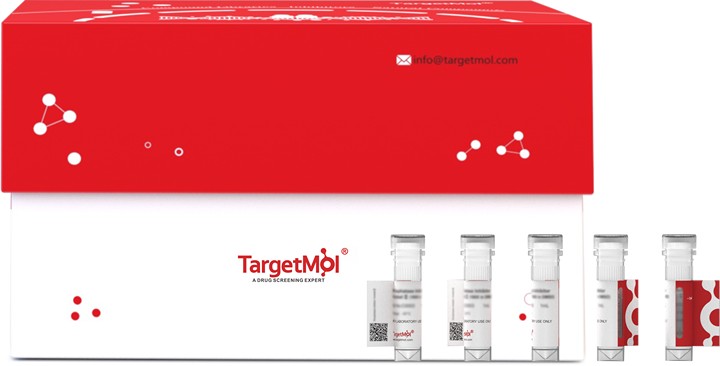 Your shopping cart is currently empty
Your shopping cart is currently empty
GBA3 Protein, Human, Recombinant (His)
Cytosolic beta-glucosidase, also known as Cytosolic beta-glucosidase-like protein 1, GBA3, CBG and CBGL1 is a cytoplasm protein which belongs to theglycosyl hydrolase 1 family and Klotho subfamily. GBA3 / CBGL1 is a glycosidase probably involved in the intestinal absorption and metabolism of dietary flavonoid glycosides. GBA3 / CBGL1 is present in small intestine (at protein level). GBA3 / CBGL1 is expressed in liver, small intestine, colon, spleen and kidney. GBA3 / CBGL1 is down-regulated in renal cell carcinomas and hepatocellular carcinomas. GBA3 / CBGL1 is able to hydrolyze a broad variety of glycosides including phytoestrogens, flavonols, flavones, flavanones and cyanogens. GBA3 / CBGL1 possesses beta-glycosylceramidase activity and may be involved in a nonlysosomal catabolic pathway of glycosylceramide.

GBA3 Protein, Human, Recombinant (His)
| Pack Size | Price | USA Warehouse | Global Warehouse | Quantity |
|---|---|---|---|---|
| 5 μg | $108 | 7-10 days | 7-10 days | |
| 10 μg | $178 | 7-10 days | 7-10 days | |
| 20 μg | $296 | 7-10 days | 7-10 days | |
| 50 μg | $696 | 7-10 days | 7-10 days |
Product Information
| Biological Activity | Measured by its ability to hydrolyze 4-methylumbelliferyl-β-D glucopyranoside. The specific activity is >1,500 pmoles/min/μg. |
| Description | Cytosolic beta-glucosidase, also known as Cytosolic beta-glucosidase-like protein 1, GBA3, CBG and CBGL1 is a cytoplasm protein which belongs to theglycosyl hydrolase 1 family and Klotho subfamily. GBA3 / CBGL1 is a glycosidase probably involved in the intestinal absorption and metabolism of dietary flavonoid glycosides. GBA3 / CBGL1 is present in small intestine (at protein level). GBA3 / CBGL1 is expressed in liver, small intestine, colon, spleen and kidney. GBA3 / CBGL1 is down-regulated in renal cell carcinomas and hepatocellular carcinomas. GBA3 / CBGL1 is able to hydrolyze a broad variety of glycosides including phytoestrogens, flavonols, flavones, flavanones and cyanogens. GBA3 / CBGL1 possesses beta-glycosylceramidase activity and may be involved in a nonlysosomal catabolic pathway of glycosylceramide. |
| Species | Human |
| Expression System | Baculovirus Insect Cells |
| Tag | C-His |
| Accession Number | A8K9N1 |
| Synonyms | MGC126878,MGC104276,KLrP,glucosidase, β, acid 3 (gene/pseudogene),glucosidase, beta, acid 3 (gene/pseudogene),GLUC,GBA3,CBGL1,CBG |
| Construction | A DNA sequence encoding the human GBA3 (NP_066024.1) (Met 1-Leu 469) was fused with a polyhistidine tag at the C-terminus. Predicted N terminal: Met 1 |
| Protein Purity | > 90 % as determined by SDS-PAGE |
| Molecular Weight | 55 kDa (predicted); 50 kDa (reducing conditions) |
| Endotoxin | < 1.0 EU/μg of the protein as determined by the LAL method. |
| Formulation | Lyophilized from a solution filtered through a 0.22 μm filter, containing 20 mM Tris, 500 mM NaCl, 10% glycerol, pH 7.4. Typically, a mixture containing 5% to 8% trehalose, mannitol, and 0.01% Tween 80 is incorporated as a protective agent before lyophilization. |
| Reconstitution | A Certificate of Analysis (CoA) containing reconstitution instructions is included with the products. Please refer to the CoA for detailed information. |
| Stability & Storage | It is recommended to store recombinant proteins at -20°C to -80°C for future use. Lyophilized powders can be stably stored for over 12 months, while liquid products can be stored for 6-12 months at -80°C. For reconstituted protein solutions, the solution can be stored at -20°C to -80°C for at least 3 months. Please avoid multiple freeze-thaw cycles and store products in aliquots. |
| Shipping | In general, Lyophilized powders are shipping with blue ice. |
| Research Background | Cytosolic beta-glucosidase, also known as Cytosolic beta-glucosidase-like protein 1, GBA3, CBG and CBGL1 is a cytoplasm protein which belongs to theglycosyl hydrolase 1 family and Klotho subfamily. GBA3 / CBGL1 is a glycosidase probably involved in the intestinal absorption and metabolism of dietary flavonoid glycosides. GBA3 / CBGL1 is present in small intestine (at protein level). GBA3 / CBGL1 is expressed in liver, small intestine, colon, spleen and kidney. GBA3 / CBGL1 is down-regulated in renal cell carcinomas and hepatocellular carcinomas. GBA3 / CBGL1 is able to hydrolyze a broad variety of glycosides including phytoestrogens, flavonols, flavones, flavanones and cyanogens. GBA3 / CBGL1 possesses beta-glycosylceramidase activity and may be involved in a nonlysosomal catabolic pathway of glycosylceramide. |
Dose Conversion
Calculator
Tech Support
Keywords
| Size | Quantity | Unit Price | Amount | Operation |
|---|

Copyright © 2015-2025 TargetMol Chemicals Inc. All Rights Reserved.



